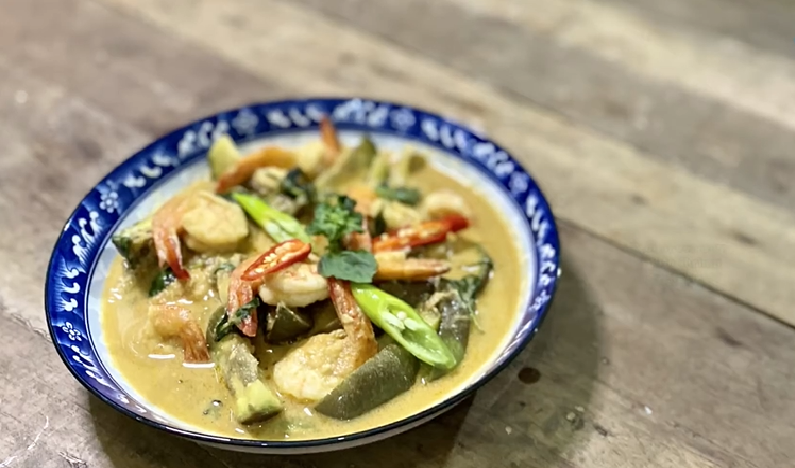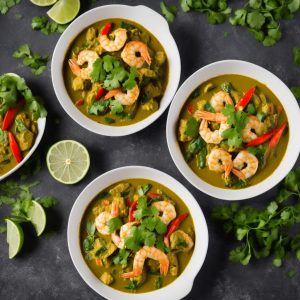This mouth-watering Thai Green Curry Coconut Shrimp with Basil recipe combines the flavors of fresh basil and green curry paste, with the sweetness of coconut milk. The shrimp is cooked to perfection, carrying the rich and aromatic flavors. This dish is a beautiful blend of the traditional Thai ingredients that results in a symphony of taste and texture.

The key ingredients of this recipe such as Thai green curry paste, Thai fish sauce, and light coconut milk might not be commonly found in your regular pantry. However, these are essential for the authentic Thai flavor. They can be found in the Asian section of most supermarkets or in specialty Asian grocery stores. Fresh basil is another key ingredient that adds a unique aroma to the dish.
Ingredients for Thai Green Curry Coconut Shrimp with Basil
Coconut oil: This oil is used for its unique flavor and health benefits.
Small scallions: These onions provide a nice sharp flavor.
Thai green curry paste: This paste is what gives the dish its iconic Thai flavor.
Garlic cloves: Garlic cloves add a robust flavor.
Shrimp: This is the main protein of the dish.
Light coconut milk: This milk provides a sweet and creamy texture.
Thai fish sauce: This sauce adds an essential salty and savory flavor.
Fresh basil: Basil leaves provide a distinct and fresh aroma.
One reader, Baird Lorenzo says:





This Thai green curry coconut shrimp with basil recipe is a game-changer! The flavors are so vibrant and the shrimp is perfectly cooked. The combination of coconut milk and Thai curry paste creates a rich and aromatic sauce that's simply irresistible. It's a must-try for any seafood lover!
Techniques Required
How to sauté scallions and green curry paste: In a large nonstick skillet or wok, heat oil on medium-high flame. Add scallion whites and green curry paste, then sauté for one minute.
How to cook shrimp: Add shrimp and garlic to the skillet, season with salt, and cook for about 2 to 3 minutes or until the shrimp is pink and cooked through.
How to simmer with coconut milk and fish sauce: After cooking the shrimp, add coconut milk and fish sauce to the skillet, then mix well. Simmer for about 2 to 3 minutes to allow the flavors to meld together.
How to garnish with scallion greens and basil: Once the dish is removed from heat, mix in the scallion greens and basil to add a fresh and aromatic finish to the dish.
How To Make Thai Green Curry Coconut Shrimp with Basil
Serve this Thai green curry coconut shrimp over rice for a decadent and filling meal. Made with coconut milk and green curry paste blended with shrimp.
Serves:
Ingredients
- 1tspcoconut oil
- 4small scallions,whites and greens separated, chopped
- 1tbspThai green curry paste,or more to taste
- 2garlic cloves,minced
- 1lbshrimp,peeled and deveined
- 6ozlight coconut milk
- 2tspThai fish sauce
- 2tbspfresh basil,chopped
- salt,to taste
Instructions
-
In a large nonstick skillet or wok, heat oil on medium-high flame. Add scallion whites and green curry paste; sauté for one minute.
-
Add shrimp and garlic, season with salt, and cook for about 2 to 3 minutes.
-
Add coconut milk, fish sauce, and mix well. Simmer for about 2 to 3 minutes or until shrimp is cooked through.
-
Remove from heat, mix in scallion, greens, and basil. Serve over basmati rice or caulirice and enjoy!
Nutrition
- Calories: 133.78kcal
- Fat: 5.49g
- Saturated Fat: 3.56g
- Trans Fat: 0.02g
- Monounsaturated Fat: 0.38g
- Polyunsaturated Fat: 0.44g
- Carbohydrates: 3.50g
- Fiber: 0.36g
- Sugar: 1.07g
- Protein: 16.02g
- Cholesterol: 143.25mg
- Sodium: 907.66mg
- Calcium: 74.84mg
- Potassium: 177.20mg
- Iron: 0.58mg
- Vitamin A: 70.67µg
- Vitamin C: 2.21mg
Technique Tip for Thai Green Curry Coconut Shrimp with Basil Recipe
When cooking with shrimp, it's important to not overcook them as they can become tough and lose their succulent flavor. The shrimp are done as soon as they turn pink. Also, using fresh basil instead of dried will give your Thai green curry a more authentic and vibrant flavor. Remember to add it towards the end of the cooking process to preserve its aroma and taste.
Time-Saving Tips for Preparing Thai Green Curry Coconut Shrimp with Basil
Prep ahead: Chop vegetables, measure ingredients, and prepare the sauce in advance to streamline the cooking process.
One-pot wonders: Opt for one-pot recipes to minimize clean-up and save time on dishwashing.
Frozen shortcuts: Use pre-peeled and deveined frozen shrimp to skip the time-consuming prep work.
Quick cook: Choose smaller shrimp for faster cooking, reducing the overall cooking time.
Efficient multitasking: While the curry simmers, prepare the rice or caulirice to make the most of your time in the kitchen.
Substitute Ingredients For Thai Green Curry Coconut Shrimp with Basil Recipe
coconut oil - Substitute with vegetable oil: Coconut oil can be substituted with vegetable oil, which has a neutral flavor and can be used as a suitable replacement for sautéing or frying.
scallions - Substitute with chopped shallots: Shallots can be used as a substitute for scallions, providing a similar mild onion flavor to the dish.
thai green curry paste - Substitute with homemade green curry paste: If you don't have store-bought green curry paste, you can make your own using a blend of fresh green chilies, lemongrass, ginger, and other spices.
garlic cloves - Substitute with garlic powder: Garlic powder can be used as a substitute for fresh garlic cloves, providing a similar flavor without the need for chopping or mincing.
shrimp - Substitute with chicken breast: Chicken breast can be used as a substitute for shrimp, providing a different protein option while still absorbing the flavors of the curry.
light coconut milk - Substitute with unsweetened almond milk: Unsweetened almond milk can be used as a substitute for light coconut milk, providing a creamy texture without the coconut flavor.
thai fish sauce - Substitute with soy sauce: Soy sauce can be used as a substitute for fish sauce, providing a salty and savory flavor to the dish.
fresh basil - Substitute with fresh cilantro: Fresh cilantro can be used as a substitute for basil, providing a similar herbaceous flavor to the dish.
Elevate Your Presentation of This Delightful Shrimp Dish
Elevate the plating: When presenting the Thai green curry coconut shrimp with basil, focus on creating an elegant and visually appealing plate. Use fresh herbs and edible flowers to add color and vibrancy to the dish.
Incorporate contrasting textures: Introduce elements of crunch and crispness to the dish by garnishing with toasted coconut flakes or crushed peanuts. This will add a delightful textural contrast to the succulent shrimp and creamy curry.
Focus on precision: Pay attention to the placement of each component on the plate. Arrange the shrimp in a visually appealing manner and drizzle the coconut curry sauce with finesse, ensuring that each element is thoughtfully positioned.
Utilize elegant serving ware: Choose serving dishes that complement the vibrant colors of the dish. Opt for sleek, modern plates or bowls that will enhance the overall presentation.
Incorporate artistic drizzling: Use a small spoon or squeeze bottle to create artistic drizzles of coconut milk or green curry sauce on the plate, adding a touch of sophistication to the presentation.
Essential Kitchen Tools for Crafting Thai Green Curry Coconut Shrimp
Skillet or Wok: A large nonstick skillet or wok is ideal for sautéing and cooking the shrimp and curry paste.
Nonstick skillet: This will help prevent the shrimp from sticking and ensure even cooking.
How To Store and Freeze Thai Green Curry Coconut Shrimp
To store leftover thai green curry coconut shrimp, allow it to cool completely to room temperature before transferring it to an airtight container. Seal the container tightly and place it in the refrigerator, where it will keep for up to 3-4 days.
When you're ready to reheat the stored curry, simply transfer the desired portion to a microwave-safe dish and heat it in the microwave until it's warmed through, stirring occasionally to ensure even heating. Alternatively, you can reheat the curry in a saucepan over medium-low heat, stirring gently until it's heated through.
If you want to freeze the thai green curry coconut shrimp for later use, allow it to cool completely before transferring it to a freezer-safe container or resealable plastic bag. Remove as much air as possible from the bag before sealing it to prevent freezer burn. Label the container or bag with the date and contents, and place it in the freezer, where it will keep for up to 2-3 months.
To thaw frozen thai green curry coconut shrimp, transfer the container or bag from the freezer to the refrigerator and allow it to thaw overnight. Once thawed, reheat the curry in the microwave or on the stovetop as described above until it's heated through. Be sure to consume the thawed and reheated curry within 2-3 days for optimal quality and safety.
It's important to note that the texture of the shrimp may change slightly after freezing and thawing, becoming slightly softer or more delicate. However, the flavor of the curry should remain delicious and satisfying.
How To Reheat Leftovers
Reheat the thai green curry coconut shrimp in a skillet or wok over medium heat, stirring occasionally, until heated through and the shrimp is warm and tender. This method helps to preserve the texture of the shrimp and the flavors of the curry.
For a quick and easy reheating option, microwave the leftover thai green curry coconut shrimp in a microwave-safe dish, covered with a damp paper towel, for 1-2 minutes or until heated through. Stir the curry halfway through the reheating process to ensure even heating.
If you have leftover rice or caulirice, reheat it separately in the microwave or on the stovetop, and then serve the reheated thai green curry coconut shrimp over the warm rice for a complete meal.
To add a fresh twist to your leftover thai green curry coconut shrimp, create a cold salad by tossing the chilled curry with fresh greens, sliced cucumbers, and chopped peanuts. Drizzle with a tangy lime vinaigrette for a refreshing and flavorful lunch option.
Transform your leftover thai green curry coconut shrimp into a comforting soup by adding it to a pot of simmering chicken broth or vegetable stock. Toss in some fresh vegetables like bok choy, mushrooms, and bell peppers for added nutrition and flavor. Serve the hot soup with a squeeze of lime juice and a sprinkle of fresh cilantro.
Random Fact about Thai Green Curry Coconut Shrimp with Basil Recipe:
Thai green curry coconut shrimp with basil is a popular dish in Thailand and is known for its unique combination of flavors. The use of green curry paste, coconut milk, and fresh basil creates a rich and aromatic sauce that pairs perfectly with the tender shrimp. This dish is a great source of lean protein and healthy fats, making it a nutritious and delicious option for a meal. Additionally, the use of Thai fish sauce adds a depth of umami flavor to the dish, enhancing its overall taste. It's a perfect dish for those who love the bold and vibrant flavors of Thai cuisine.
Is Preparing Thai Green Curry Coconut Shrimp at Home Cost-Effective?
This Thai green curry coconut shrimp with basil recipe is moderately cost-effective for a household. The use of shrimp and coconut milk may increase the cost, but the dish's flavors and nutritional value justify the expense. The approximate cost for a household of 4 people is around $25-$30. The dish's rich and aromatic flavors, combined with the health benefits of shrimp and coconut milk, make it a worthwhile investment. Overall, this recipe earns a solid 8/10 for its taste, nutritional value, and overall appeal.
Is Thai Green Curry Coconut Shrimp with Basil Healthy?
This Thai green curry coconut shrimp recipe is a healthier option compared to many other shrimp dishes. The use of light coconut milk reduces the overall calorie and fat content, while the inclusion of scallions and basil adds a fresh, aromatic flavor and provides some essential vitamins and minerals. The shrimp itself is a lean protein source, low in calories and high in nutrients like selenium, vitamin B12, and omega-3 fatty acids.
However, there are a few aspects of this recipe that could be improved to make it even healthier:
- Increase the amount of vegetables in the dish by adding bell peppers, carrots, or snap peas to boost the fiber content and provide a wider range of vitamins and minerals
- Opt for brown rice or quinoa instead of white rice to increase the fiber and nutrient content of the accompanying grain
- Use a reduced-sodium fish sauce to lower the overall sodium content of the dish
- Consider using a homemade green curry paste to have better control over the ingredients and reduce the amount of added salt and preservatives
By incorporating more vegetables and opting for whole grains, you can enhance the nutritional value of this already healthy Thai green curry coconut shrimp recipe. These changes will not only make the dish more nutrient-dense but also add more texture and depth of flavor to the overall meal.
Editor's Thoughts on Thai Green Curry Coconut Shrimp with Basil Recipe
This Thai green curry coconut shrimp with basil recipe is a delightful fusion of flavors. The combination of the aromatic green curry paste, creamy coconut milk, and succulent shrimp creates a harmonious balance. The addition of fresh basil adds a refreshing herbal note, elevating the dish to a new level. The use of scallions and garlic enhances the depth of flavor, while the Thai fish sauce provides a savory umami element. This dish is a perfect blend of Thai cuisine and seafood, offering a delightful and satisfying dining experience.
Enhance Your Thai Green Curry Coconut Shrimp with Basil Recipe with These Unique Side Dishes:
Delectable Alternatives to Thai Green Curry Coconut Shrimp with Basil
Appetizers and Desserts to Complement Thai Green Curry Coconut Shrimp
Why trust this Thai Green Curry Coconut Shrimp with Basil Recipe:
This recipe guarantees a delightful fusion of flavors, ensuring a tantalizing experience for your taste buds. The combination of succulent shrimp and aromatic Thai green curry paste creates a harmonious blend, while the addition of creamy coconut milk and fragrant basil elevates the dish to a whole new level. The use of coconut oil and Thai fish sauce further enhances the authenticity of this recipe, promising an exquisite culinary journey. Trust in the expertise of this recipe to deliver a sensational dining experience, showcasing the finest elements of Thai cuisine in every delectable bite.
Was this page helpful?
Have your own special recipe to share? Submit Your Recipe Today!















